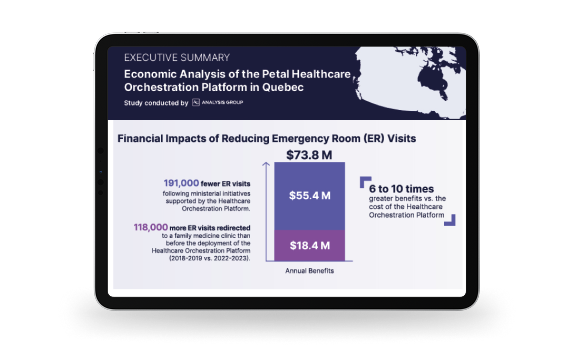Key takeaways
- Real-time visibility prevents blind spots: A centralized, always-updated on-call directory eliminates errors and missed coverage.
- Automation reduces risk and admin burden: Equitable, rules-based scheduling and instant updates keep coverage accurate and fair.
- Secure messaging accelerates response: Role-based alerts and compliant communication ensure the right provider is reached—fast and safely.
When a patient arrives in the Emergency Department at 2:00 a.m., every minute matters. Yet too often, an outdated on-call list or a missed shift swap forces operators and charge nurses to call down a list in the hopes of finding the right specialist who’s actually available. The result: delays, frustration, and avoidable risk.
The solution isn’t just better schedules—it’s real-time visibility, automation, and secure communication that ensures the right provider gets the right alert instantly. Here are three practical steps any hospital or health system can take to eliminate coverage gaps and accelerate care team coordination.
Step 1: Establish one real‑time view of coverage and capacity
Spreadsheets, bulletin boards, and local lists fragment visibility. A single change in one department rarely propagates everywhere in the time required. This leads to stale on-call directories, missed shift exchanges, and blind spots during off-hours.
Move to one source of truth for your clinical workforce:
- Real-time dashboards display capacity by provider type and specialty across departments and sites.
- An always-updated on-call directory reflects shift swaps and absences the moment they occur.
- API integrations feed downstream systems and support decision-making, billing reporting, and compliance.
Petal Workforce Management gives leaders and operators complete visibility across departments and hospitals. No more detective work in identifying gaps for a critical change when a patient’s condition escalates and the hospital must locate the right physician immediately. The call center, the department scheduler, and the house supervisor now share the same live information, which reduces handoff friction and avoids duplicate outreach.
The outcome: fewer errors, fewer misses, and faster access to the right on-call specialist.
Step 2: Automate scheduling for equity, efficiency, and fewer errors
Manual scheduling introduces inconsistency and inequity. It also wastes administrative time and often overlooks rules that matter to clinicians, such as post-call recovery, distribution fairness, or specialty-specific constraints.
A modern, automated scheduling engine enforces rules fairly while dramatically shrinking build times:
- Automated, equitable scheduling respects constraints and balances nights, weekends, and holidays.
- Self-serve shift swaps leave control with providers while updates flow across the system instantly.
- Absence tracking and calendar sync ensure every change updates the on-call directory without rekeying.
Health systems using Petal Workforce Hub report measurable gains:
- Up to 98% reduction in time spent creating schedules.
- Up to Réduction 70% in costs tied to scheduling tasks.
Automation removes drudgery, improves fairness, and eliminates the manual “paper trail” that causes gaps. In short: fewer errors, smoother operations, and a predictable on-call roster that stays accurate minute-to-minute.
Step 3: Close gaps fast with smart outreach and secure messaging
Even with strong schedules, unexpected changes happen. These include last-minute absences, census spikes, or urgent consults. The key to avoiding delays is clear, rapid, and secure communication that connects the right provider at the right time.
Best practices for rapid coverage coordination:
- Use role-based alerts to target the correct on-call provider and avoid unnecessary call chains.
- Ensure secure, compliant messaging to protect patient information and maintain privacy standards.
- Provide mobile and web access so teams can respond from anywhere. Anytime.
- Maintain centralized oversight for urgent coordination to prevent duplication and confusion.
- Keep audit logs for accountability and quality improvement.
When these practices are in place, operators and clinical staff can reach the right physician on the first attempt—not the third. That accuracy translates into safer handoffs, faster decisions, and fewer delays.
“To improve the quality of care offered by our network, we wanted to modernize the management of our medical on-calls, as it was not optimal. What we wanted was a centralized on-call list, always up to date and accessible at all times by all physicians and employees in the network. These objectives were achieved by acquiring the solution developed by Petal.”
— Dr. Quentin Dulière, Assistant Medical Director, CHC Care Network
Why these steps work together
Hospitals don’t need a better directory or a faster pager. They need a connected workflow:
- Visibility exposes coverage gaps before they compromise care.
- Automation prevents errors and maintains equitable schedules.
- Secure communication closes the loop swiftly when urgent coverage needs arise.
Petal Workforce Hub unifies these pillars across departments and sites, giving leaders a single operating picture. The result: smarter staffing decisions, less administrative burden, and a rapid response when the stakes rise.
It’s also a solution the industry recognizes. Petal Workforce Hub appears in the 2024 and 2025 Gartner Hype Cycle for Real‑Time Health System Technologies, underscoring its role in modern healthcare workforce management.
Quick audit: Are you ready to prevent coverage gaps?
Use this checklist to spot risk and prioritize next steps:
- One centralized, always-updated on-call directory across the enterprise
- Real-time dashboards by provider type, specialty, and site
- Automated, rules-based scheduling with equity built in
- Self-serve swaps and absence tracking that sync instantly
- Secure, role-based alerts and messaging for urgent coordination
- Audit logs and APIs for decision support, billing, and accountability
If any item sits unchecked, your teams likely experience avoidable delays, after-hours frustration, and rising burnout.
From scramble to seamless
When an ICU admission or emergency department case triggers a complex consult, guessing who’s truly available introduces risk. A real-time, automated, and secure communication workflow removes guesswork and accelerates care. That’s the shift innovative hospitals pursue as they modernize on-call operations and protect patient safety around the clock.
See how Petal Workforce Hub streamlines clinical workforce operations across your network.
→ Streamline clinical workforce operations
→ Download the Cost‑Benefit Analysis of Petal’s Workforce solutions
Keywords for CMS
- on-call coverage gaps
- hospital workforce management
- automated physician scheduling
- secure clinical communication
- real-time on-call directory

![PT_VOMBSFP_202509_EN[1]](https://www.petal-health.com/wp-content/uploads/2025/10/PT_VOMBSFP_202509_EN1.png)
![Rapport économiquepouce-non-arrière-plan(1)[1]](https://www.petal-health.com/wp-content/uploads/2025/10/Economic20report20thumb-no20background2011-768x548.png)